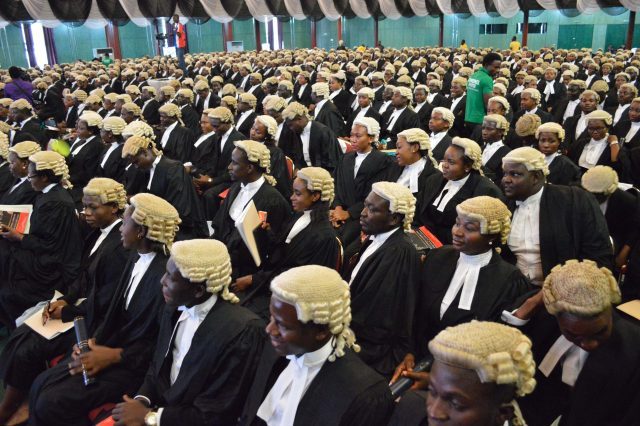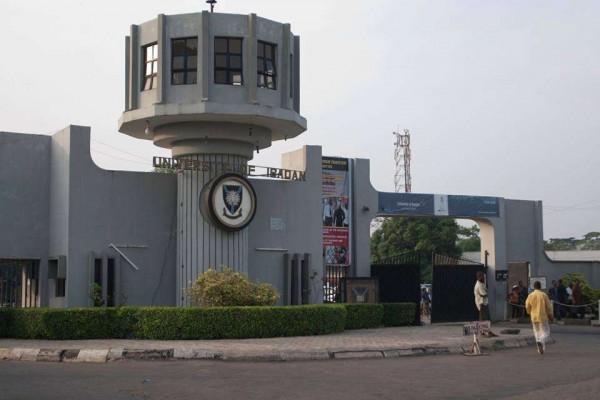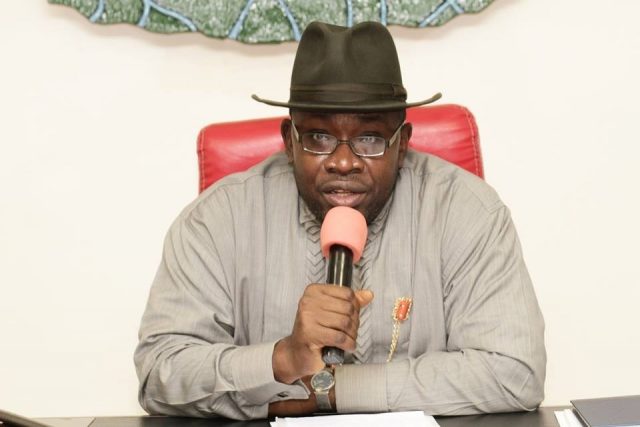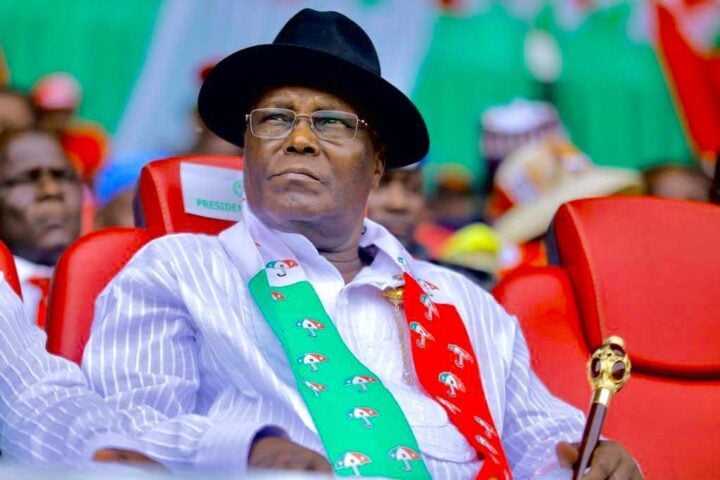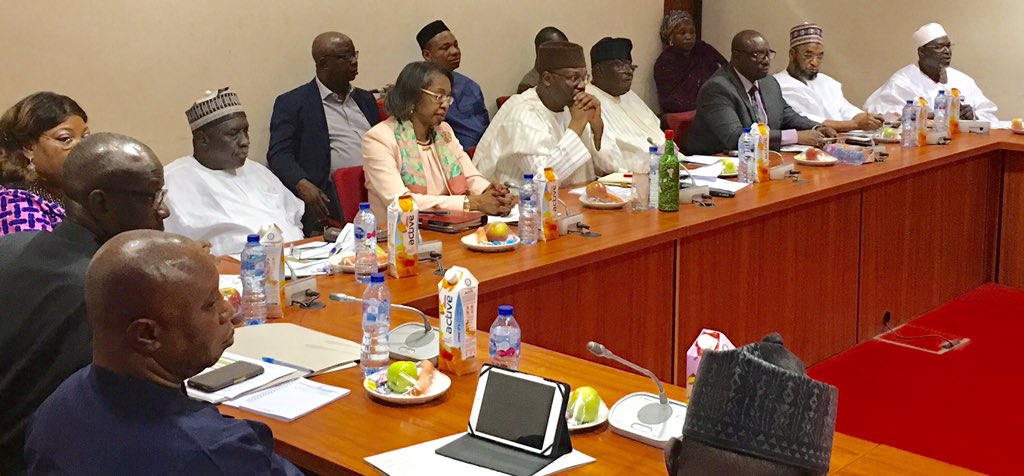Pope kisses feet of rival South Sudan leaders
BY FRANCIS ANEKWE OBORJI
Some few days ago, Pope Francis captivated the world once again with a rare symbolic gesture that knows no bound. It happened at the Vatican, where the Pontiff hosted the two rival, previous warring leaders of the war-torn South Sudan. In an unexpected rare gesture, Pope Francis went out of his way, humble, but always majestic. He kissed the feet of the South Sudan warring leaders, imploring them to maintain the “fragile” peace that exists between them.
On Thursday, April 11, 2019, during a two-day spiritual retreat at the Vatican, the Pope pleaded with President SalvaKiir and Riek Machar, his former deputy turned rebel leader, and three other vice presidents to honour the armistice they signed and commit to forming a unity government in May.
Addressing these two rival leaders of South Sudan, Pope Francis said:
Advertisement
“I am asking you as a brother to stay in peace. I am asking you with my heart, let us go forward. There will be many problems but they will not overcome us. Resolve your problems.”
Thereafter, the Pope performed the rare gesture. Speaking in Italian, he added that “but in front of the people, hold hands united. So, as simple citizens, you will become fathers of the nation.”
As one Newspaper reported it:
Advertisement
“The leaders were apparently shocked to see the 82-year-old Pontiff – who helped by aides – got on his knees with difficulty to kiss the shoes of the two main opposing leaders and several other people in the room.”
Kiir and Machar had clashed in 2013, leading to a civil war that left about a million people in South Sudan dead. The duo however, signed a peace agreement in 2018 that brought the war to an end.The Pontiff’s dramatic and unprecedented gesture is coming barely hours after the military in neighbouring Sudan ousted President Omar al-Bashir, its long-time leader, after 30 years of authoritarian rule.
Pope Francis’ rare gesture is symbolic. It is a symbolic gesture, which raises anew to the conscience of the world, about the other ongoing fratricidal wars and conflicts in various African nations states. These include the following:
The unresolved conflicts and violence inthe Anglophone regionof Southern Cameroun,Central African Republic, Democratic Republic of Congo; and in many countries of West African-sub-region, – Nigeria, Chad, Niger, Togo, Burkina-Faso, Ivory Coast, etc. The gesture has echoes also on the ongoing conflicts and violence in some countries of the Horn of Africa as well as in the North African country of Libya.
Advertisement
Furthermore, the Pope’s dramatic gesture happened at the time of the 25th Commemoration on April 7, of the victims of over one million Tutsi killed during the Rwandan Genocide of 1994. In addition,the Papal gesture comes on the hills of May 30th, when the people of the former Eastern region of Nigeria (defunct Biafra enclave), commemoratethe victims of over 3.5 million Igbos and other Easterners killed during the Nigeria-Biafra fratricidal war (1967-1970).
The Biafran Pogroms, which unfortunately, the federal government of Nigeria and Britain – Nigeria’s former colonial masters and the war ally, have been doing everything possible to suppress, and even deny it ever happened, is an “unhealed open wound” to the conscience of the world and humanity. Those powerful countries, Britain and its allies, which fought on the side of Nigerian federal government against the people of the former Eastern region of Nigeria (Biafra), don’t want this open wound to be discussed anywhere today in the world, – in any international arena and in the mainstream national and international media.
Unfortunately, the unhealed memory of the wounds of the Biafran pogroms, is one of the major reasons bloodbath, chronic violence, Islamic terrorism, lopsided federal government, military impunity and recklessness, kidnapping, daily destruction of lives and property of innocent citizens, and especially political instability have remained as second nature to Nigerian state ever since.This is one major reason also why there is a near total breakdown of rule of law and order in that country today, and why political corruption, fraudulent elections and massive riggings are the order of the day.
All these show how urgent today Africa is groaning for a new beginning, shaped with language, actions, images, gestures and symbols that promote restoration, reconciliation, justice and peace in different African nation states that are still steeped in intractable mutual conflicts, ethnic-hate, religious bigotry, power tussle, terrorism, violence and wars. This is the background of our appreciating in this article, the rare gesture of Pope Francis in pleading for peace in South Sudan with the two principal rival leaders of that African country.
Advertisement
In general, anyone familiar with the Pontificate of Pope Francis since his election to the Papal throne in 2013 will discover immediately, a sincere effort of this holy man of God to speak and communicate directly, with men and women of our time, in a simple language most accessible to the human mind and heart. Since his election as the Bishop of Rome and Pastor of the worldwide Catholic Church, Pope Francis has adopted an approach of communicating and reaching the people, far and near, – all over the world, with simple gestures, in words, symbols, images, and especially, during liturgical celebration. This is one of the most visible aspects, the so-called, Pope Francis’ “factor”, the world has come to admire and appreciate. It is a communication style of the Roman Pontiff, which has captivated the entire world, Catholics and non-Catholics alike.
In all his writings, speeches and homilies, Pope Francisalways uses a simple language, full of meaning, but suffused with symbolic gestures that speak directly to human hearts and minds of all classes of people of our contemporary world, old and young, rich and poor, the learned and unlettered. His, is a language of communication, which echo, cuts across the present geopolitical configurations of the world – North and South, Old and Young Churches. An inclusive language of communication that gives priority to the ever-increasinghumiliating situation of the poor and marginalized in our contemporary world.
Advertisement
Themain thrust of our present article therefore, is on the prophetic nature of that symbolic gesture of Pope Francis when he hosted the two rival leaders of the war-torn South Sudan in the Vatican. Discussed in the context of the ongoing and unresolved conflicts in many troubled African nations today, our article makes a positive evaluation of the Pope’s symbolic gesture of “kissing” the feet of the rival leaders of South Sudan in pleading for peace and reconciliation in the conflict-inflicted African nation.
It discusses Pope Francis’ symbolic gesture for peace in South Sudan as prophetic, and as a challenge to church leaders and Christians in Africa. A challenge to church leaders and Christians, especially, in those African countries where chronic conflicts and violence are still the order of the day, – places and nations, where no serious and sincere efforts have been made yet towards achieving healing and reconciliation after a brutal war of genocides and pogroms.
Advertisement
What will be the role of the Church in Africa today? That is, towards achieving restoration, reconciliation, healing, justice and peace in an African country, where people arestill living in constant situation of mutual conflicts, violence, hatred and ethnic cleansing; where political instability and lopsided government have stunted all efforts towards moving the country forward. Where the government and other state actors are incompetent, unwilling to give peace a chance,and likely accomplice of these crimes. Most often, these crimes are as a result of excessive ethnocentrism, religious bigotry, lust for power of a privileged few, suppressing the past memory of a wounded group, and unmitigated foreign interests in those African countries with rich natural and mineral resources.
Of course, there are other factors! The ones enumerated here, however, are enough to show us how urgent the question of restoration of the dignity of the wounded, reconciliation and healing are today in Africa for the survival of many nation states of the continent. This is why one must not ignore the rare symbolic gesture of Pope Francis when he hosted the two rival leaders of South Sudan in the Vatican, pleading for reconciliation and healing.
Advertisement
THE SIGNIFICANCE OF POPE FRANCIS’ GESTURE OF RECONCILIATION
After going through an article written in French by one of our African priests in Rome, Fr. Armand Abeme from Camroun, some days ago, on that symbolic gesture of Pope Francis for Peace and Reconciliation in South Sudan,I was movedby his recognition of the Pope’s gesture as “prophetic.” His, in all sincerity, inspired our present article.
Some people may, at first observation not recognize the prophetic meaning in the Pope’s gesture. With hindsight, however, it is a gesture full of prophetic meaning and significance. Symbolic gestures both in the Biblical world and in our African traditional culture and thought, carry with them rich meaning that transcends the observable reality, but which point to “a New World”, a “New Creation” – a new society and way of being and relationships, people have been yearning for.
This is exactly, what symbol means. Symbols are at the heart of all cultures and relationships among humans: between them and God, visible and invisible world, the universe. It is for this reason that experts in cultural anthropology define cultures as “web of meaning or significance.” Cultures establish symbolic gestures, templates and blueprints that define the limits of behaviour and guide it along predictable routes. This is the hinge of the prophetic nature of symbolic gestures and signs.
A symbol is more than a sign. Signs only point to the object signified, but symbols by their very dynamism re-present the object. They carry the meaning and values in themselves that permit them to articulate the signified rather than merely announce it. Symbols bring alive in the imagination of its people, the meaning of what it signified, in a way that restores the people’s sense of belonging and dignity.
The Holy Scripture, both Old Testament and New Testament, are full of symbolic gestures. These are gestures geared towards opening the mind of the people to the “New Creation”, God offered humanity through Jesus Christ. It is anew offer of salvation in God through Jesus Christ’s reconciling mission, symbolic gestures and actions through which we have been reconciled with God,with one another and with all created reality, thus making us a “New Creation.”
Jesus’ earthly ministry and life were suffused with actions rich in symbolic languages, gestures and meaning. It suffices to think of the Parables of Jesus, his use of everyday common symbols in communicating with ordinary people, and constant reference to things of nature, e.g., the fig tree, the Good Shepherd, the Fisherman, woman at the well, etc.
What of St. John the Evangelist, who made most use of symbolic language and images in all his Sacred Writings: the fourth Gospel, Letters, and especially in the Book of Revelation, which in effect, is a book of symbols and visions of “a new creation.” A“New World”, God was preparing for all those ready to embrace one another, endure suffering and injustice of the present time forthe sake of God’s coming eschatological rupture;thus,with hope and optimism for a better tomorrow. That is, without renouncing their faith and hope in the Risen Christ.
Symbolic language and gestures of reconciliation, carried out in the power of Christ and his Church, embody all these. This is why the Church’s role in reconciliation and healing is unique and deeper in meaning.
PROPHET EZEKIEL AND SYMBOLIC LANGUAGE OF RECONCILIATION
The African theologian and philosopher from Uganda, Emmanuel Katongole is right:
“That Ezekiel was given to symbolic actions, visions and trances indicates the “language” of the Church in a post-genocide … [African nation] time: a language of symbols, parables, and sacraments.” (E. Katongole, The Journey of Reconciliation: Groaning for a New Creation in Africa, Orbis Books, Maryknoll, New York 2017, 42).
The Book of Prophet Ezekiel, is in actual fact, a book of symbols and gestures of a “New Creation” that would arise amidst the exigencies of people living under persecutions, exile, situations of injustice, torments, lamentations and valley of tears. Out of their lamentations come Restoration.
For Ezekiel, genocides and wars such as we have them today in many African nations, bring us to the end of words, and the only language at the end of words is the language of “symbols and gestures”, like the one Pope Francis showed us the other day he hosted the two warring leaders of the war-torn South Sudan.
In that gesture, Pope Francis is addressing in particular, African Church leaders, all Christians and people of good will. The Pope wants the Church in Africa to begin to appreciate the “language” of symbols and gestures as the new language for Christian mission in the continent. If reconciliation and healing are the most urgent reality African churches are confronted with today in their evangelizing mission, then, the language for that mission is nothing other than, the “language” of symbols and gestures.
Reconciliation is the Church’s unique calling! It is a gift to live and invite others into its space of the language of Symbols:“A language of silence and lament in a way that hope is once again offered to the traumatized and shattered people.” I believe that this is what Katongole had in mind when he said that for the Church in Africa to be able to do this ministry of reconciliation and healing, it “must learn from the Prophet Ezekiel about what it means to stand in the valley of dry bones.” (Ezekiel 37).
A priest (in Jerusalem) turned prophet, Ezekiel was carried into exile in 597 BC. It is from exile that he delivers the Prophecy to his fellow Israelites in exile. There are a number of elements about the prophecy that evoke the actual situations of wars, internal conflicts and premeditated genocides going on today in various African nations today.
In other words, there are a number of aspects of Ezekiel’s life in general and his standing and actions in the “valley of dry bones”, in particular, that point to the Church’s calling, and confirm why the Church in Africa is best suited to engage the present situations of traumatized African nations and citizens. These are African nations and citizens, who because of conflicts, violence and genocidal wars are presently like people living in the “valley of dry bones.”
Again, more than any Biblical prophet, Ezekiel was given to symbolic actions, strange visions, and trances. He eats the SCROLL on which words of prophecy are written(Ezekiel 3:1-3); he LIES DOWN for extended periods (Ezekiel 4:4ff.). He took the POTTER’S FLASK and smashed it (to symbolize Israel’s being scattered). Furthermore, Ezekiel’s prophecy and symbolic language were born out of “silence of the grave” – (valley of dry bones). This could be likened to St. John of the Cross “Dark Night of the Soul.” That is, a devastating period of hopelessness and despair in the face of all consuming danger.
Early in his ministry, Ezekiel was struck dumb for an unspecified period of time(Ezekiel 3:26). It is the same Ezekiel who was struck dumb who is now brought to the valley of dry bones. This is of course, the valley of death, of hopelessness and abandonment. He must learn to stand in this situation of hopelessness and abandonment before he is ordered to prophesy.
The Church of Ezekiel therefore, is a Church that is invited into silence of death and abandonment (valley of dry bones), and yet ordered to prophesy. That Ezekiel was able to live in this call of silence of death, abandonment, of despair, and prophecy might be partly due to his double identity as priest and prophet. In this double role, the Prophet serves as the embodiment of the history, suffering, despair, and hope of his people. This partly explains a number of the symbolic actions of the prophet:
He is carried into exile; he lies down (symbolizing the death of his people). His wife dies in exile. The valley of dry bones in which Ezekiel is forced to stand is the valley of his own and his people’s death.
More significantly, when Ezekiel is asked whether the bones could live, his honest answer was “I am not sure, for they look pretty dead to me.” Involved in Ezekiel’s response is the awareness that he himself has come to the limits of his own calling. In his repertoire of prophetic/priestly ministry tools, he has no trick, no magic wand, no word, no formula that could bring about the restoration. That is when, at the end of his ministry, he is asked – nay commanded to prophesy.
In other words, the nature of Ezekiel’s prophecy is significant. He is commanded to “summon the wind from the four corners.” Just as the act of creation in Genesis begins with the wind – “ruah” hovering over the formless void (Genesis 1:1), and with God’s breath into Adam (Genesis 2), these images in Ezekiel evoke the promise and possibility of new creation (re– creation) even in the valley of dry bones. And as Ezekiel did so, there was noise, and rattling sound, as the bones began to come together.
The restoration, peace and reconciliation come as gifts from God: “When I open your graves and make you come from them, then you will know that I am the Lord.”
PRACTICAL SIGNIFICANCE OF EZEKIEL’S “VALLEY OF DRY BONES” FOR AFRICAN CHURCHES
All these elements in prophet Ezekiel’s “valley of dry bones” and prophecy, point to the critical role facing the Church today, especially in Africa. Moreover, they are very critical to the meaning we attach to the practice of worship as space and place through which the silence of the “valley of dry bones” – the state of hopelessness, despair and abandonment being experienced today in various African nation states, might be engaged. It is in worship that the Church not only receives the story of Ezekiel, but also lives into its reality. Worship offers the Church an opportunity to engage with the present African reality in a way that calls forth (summons) God’s re-creating spirit within its dry bones. In the words of Katongole:
“In worship the Church is brought to silence as it is invited (nay forced) to look into and admit its own brokenness and the brokenness of the world – and thus seek God’s mercy and healing. But in worship is also invited to shout aloud and sing God’s praises.”(E. Katongole, The Journey of Reconciliation: Groaning for a New Creation in Africa, p. 43).
So in worship, Christians are able to at once sit in silence and shout out aloud, to sit alone and yet together with others in the valley of death. In worship Christians relive the past in a way that is already taken up in God’s future as they proclaim both that Christ has died and is risen.
What this means in effect is that in worship both lament and trust, pain and hope, the crucifixion and the resurrection come together in a way that breathes new life in our own “valley of dry bones.”And yet this is not to say that worship is the trick, the formula that carries us from the valley to the sunny promise of resurrection. For this happens as a gift.
Because when we come as individuals and meet together in worship – before and in the presence of Christ, who is both priest and prophet we are being transformed into that “new state” of being. When we sing together psalms of our desperation and shattered hopes, when we celebrate the supper of the lamb who was slain but now is risen and invites us to receive him at his banquet, we discover that we are being “re-membered”, reconstituted, and even reconciled to one another.
That as we participate in these practices, symbolic gestures and movements called worship, we discover also that to a great extent, our identity as children of God has been reaffirmed as we behold God’s own Son on the Cross. Furthermore, as we grasp this gift, we discover that we have to that extent, already received the grace of forgiveness. “This is because forgiveness is not so much a card that victims hold and which they can pass out at the appropriate time to deserving perpetrators.” It is more of a gift that we receive and invite others into it.
Moreover, as a gift, reconciliation is never complete; it is never total. It is an ongoing journey. And so through worship one learns to speak about the gift in terms of “signs.” But that forgiveness is never complete does not make the signs any less real. Worship trains us to recognize these signs also as real, visible, concrete expressions of something deeper. That is why the space of worship is also the space of “parables.” It is like a mustard seed or leaven.
All this implies that if worship invites us into the space and place of lament, it invites us into a journey of hope. This is why such notions like justice, reconciliation, forgiveness, and even truth became concrete to the ordinary people of South Sudan as they watched Pope Francis extend those symbolic gestures of kissing the feet of the two main principal rival warlords of their war-torn nation, Salva Kiir and Riek Machar.
For this time of South Sudan, like the time of Ezekiel, is a time that calls for a space and place of lament. Such a space, as the life of Ezekiel shows, is a place for silence and tears, a place for prophecy, which is for summoning God’s re-creating spirit; a time and space for signs and symbols and for hope and visions of restoration, justice, peace and reconciliation.
In the absence of such a space and place for lament and restoration, it would be asking too much to invoke a notion (justice, reconciliation) or any program – including the much-touted African traditional justice system (African Palaver) – to bear the burden of carrying South Sudanese from the valley of death to the promise of a new future. That would be expecting African Palaver popular assembly reconciliation model to function as a church, which of course it is not.
All this shows why Church leaders in Africa must seriously look into the new phenomenon that has turned our churches – places of worship into an arena of “fund-raising” (endless “second collections”), and political campaigns during elections. If our churches are no longer seen as places that offer space of silence and tear, of lament, of prophecy and of summoning God’sre-creating spirit for people in the “valley of dry bones”, the danger is that they may look for this elsewhere. This is why most of our people have become victims of the charlatan pastors and self-acclaimed Prophets of the so-called prayer healing centres that have taken over the religious landscape of many African countries nowadays.
PASTORAL IMPLICATIONS FOR AFRICAN CHURCHES
We can now see whyBenedict XVI, in Africae Munus, which is the post-Synodal Exhortation of the Synod of Bishops, II Special Assembly for Africa, held in Rome in 2009, issues an explicit appeal for the Church and Christians in Africa to pursue reconciliation, justice, and peace, as the new missionary impulse and language for the Church in Africa.
Africa’s memory and experience of various traumas and conflicts make reconciliation a particularly urgent and timely gift. In fact, for the Pope Emeritus Benedict XVI, reconciliation is not simply a gift for the Church in Africa and its evangelizing mission, it is one that is urgent and timely. In this way, Africae Munus of Benedict XVI, encourages each Bishop “to put issues of reconciliation, justice and peace high up on the pastoral agenda of his diocese.” In other words, reconciliation should not be viewed only as a priority area of the Church’s mission: it is the lens through which the Church (in Africa and elsewhere) understands it’s identity and mission in the world.
In recalling Africa’s memory and experience of various traumas and conflicts, Benedict XVI in part 1 of Africae Munus speaks of Africa as a continent and space that is experiencing an “anthropological crisis” (Africae Munus 11). This crisis, arising to some extent out of Africa’s painful memory of fratricidal conflicts between ethnic groups, the slave trade, and colonization (n.9) is also connected to current problems of political instability, economic breakdown, poverty, unemployment, underdevelopment, ethnic-cleansing, political corruption, fraudulent elections and riggings, disease, environmental pollution, breakdown of law and order, etc.
Using a biblical image (147-49), Pope Benedict XVI compares Africa to the paralytic in Mark’s Gospel (2:1-12), and like the four men who brought the paralytic to Jesus, the Church in Africa is called to mobilize spiritual energies and material resources to relieve Africa’s heavy burden and open Africans to the fullness of life in Christ. The recommendation in part 2 of Africae Munus – addressed to the various constituents of the Church (99-146) – must be read within the context of crisis and as an invitation to the Church to stand in solidarity and creativity in order to remove the obstacles to Africa’s healing and reconciliation.
Pope Benedict’s depiction of Africa’s anthropological crisis in Africae Munus is powerful. Even more powerful is the conclusion that behind and connected to various social and human challenges lies a ‘spiritual crisis’ of identity. Echoing Peter in the Acts of the Apostles, Pope Benedict notes:
“What Africa needs most is neither gold nor silver; she wants to stand up, like the man at the pool of Bethzatha; she wants to have confidence in herself and in her dignity as a people loved by her God. It is this encounter with Jesus, which the Church must offer to bruised and wounded hearts yearning for reconciliation and peace, and thirsting for justice. We must prove and proclaim the word of Christ which heals, sets free and reconciles.” (Africae Munus 149).
This means a call and need for a new African identity (a new vision of itself – as God’s beloved) and a new confidence in itself and its identity that makes reconciliation a unique and rare gift for Africa. For reconciliation is not simply a program or set of skills. It is first, and foremost, an invitation to experience the new world that God has made possible. It is this new world, “New Creation”, that Paul talks about in 2 Corinthians 5:16-20.
The key reality that Paul is announcing here is not, in fact, reconciliation, but the “New Creation.” Reconciliation is the way through which God has made this new creation possible, and it is the gift that makes it possible for “anyone in Christ” to belong to this new creation of restored relationships.
In fact, it is the experience of reconciliation as a gift made possible in Christ that Pope Benedict is pointing at as the ground for reaffirming Africa’s true identity, the source of its dignity, and the basis of its mission in the world. Referring to Africa as a “spiritual lung” for humanity, Benedict XVI notes that if Africa “is to stand erect with dignity, [it] needs to hear the voice of Christ who today proclaims love of neighbour, love of even one’s enemies, to the point of laying down one’s life” (13).
If reconciliation is then a gift and invitation into a new identity, and thus a fresh starting for Africa, the primary question that relates to mission as reconciliation is how can Africa receive, enter into, and operate within this experience of new creation so as to live true to its identity and calling?
Proffering answers to this fundamental question about a new and reconciled identity for Africa is what should receive the priority of African churches and Christians in their evangelizing mission in the continent today.
CONCLUSION
Pope Francis, like his predecessor, Pope Benedict XVI, has challenged churches and Christians of Africa to embrace with renewed vigour the mission of reconciliation, healing, justice and peace. To imbibe the spirituality of reconciliation with a new language suffused with symbolic gestures and signs, – as a new way of ecclesial life that opens a “New World”, a “New Creation” for a new African identity to emerge in today’s world. Thischallenges the Africanlocal churches and Christians to begin to work towards the practice of sustained reconciliation as a way of life in Africa today.
This is a recognition of symbolic gestures as an embodiment of language of hope and triumph. A language of symbols that calls upon all and sundry to embrace the new offer of reconciliation,which we have all received as free-gift fromGod through Jesus Christ.
Symbolic actions, such as the one performed by Pope Francis for peace in the troubled African nation of South Sudan, points to the new realization of the Church of its reconciling ministry in the world today, but especially in Africa.
It is expected that African church leaders and ordinary Christians will take up this challenge of making ministry of reconciliation, a priority of Christian mission in Africa. African church leaders and ordinary Christians are invited to take clue from the symbolic gesture of Pope Francis, – multiply and reproduce it in their various domains and spheres of influence, especially, in those war-torn places, where people have been groaning for restoration, reconciliation, healing and new creation.
This is a new “God-given mission” to African churches and Christians today in their various countries.
Views expressed by contributors are strictly personal and not of TheCable.


